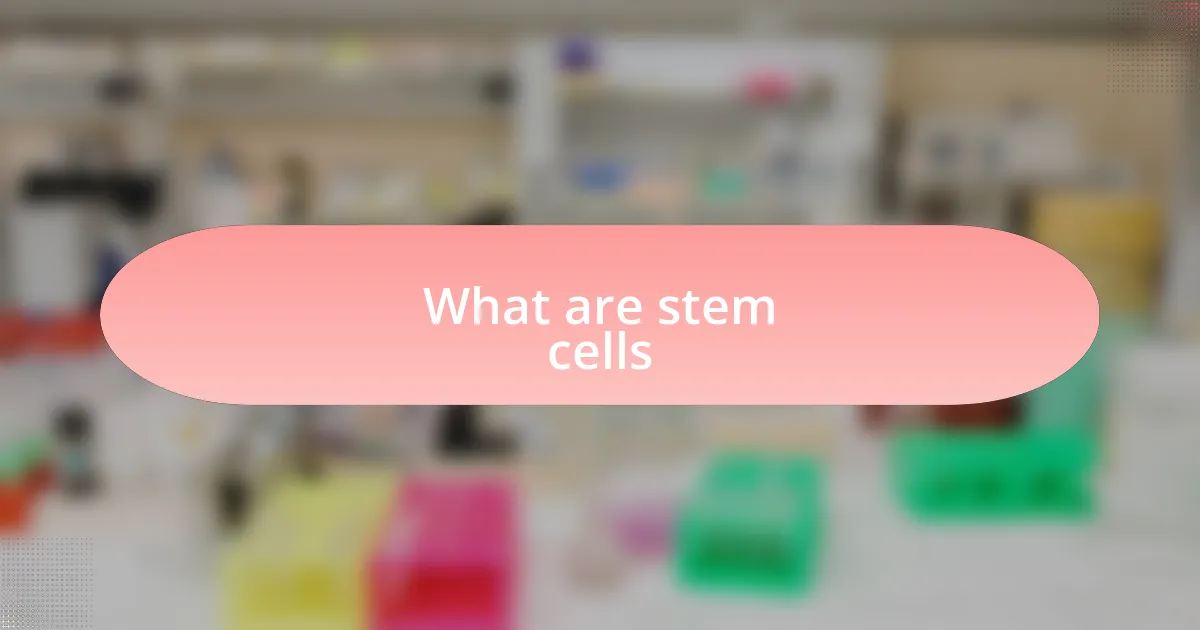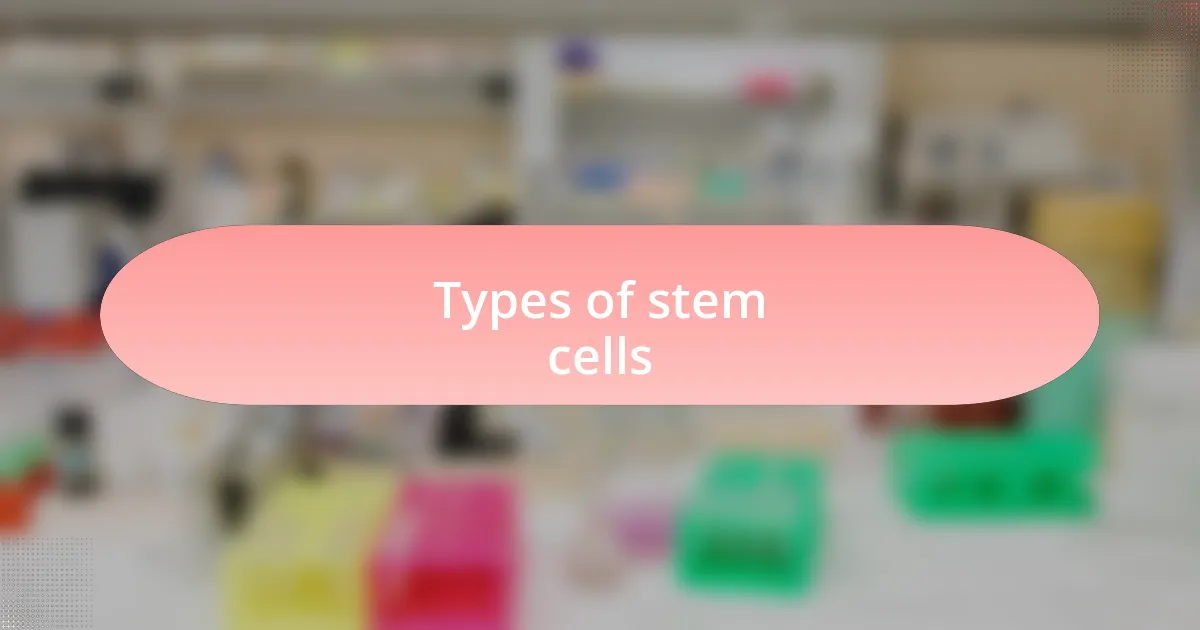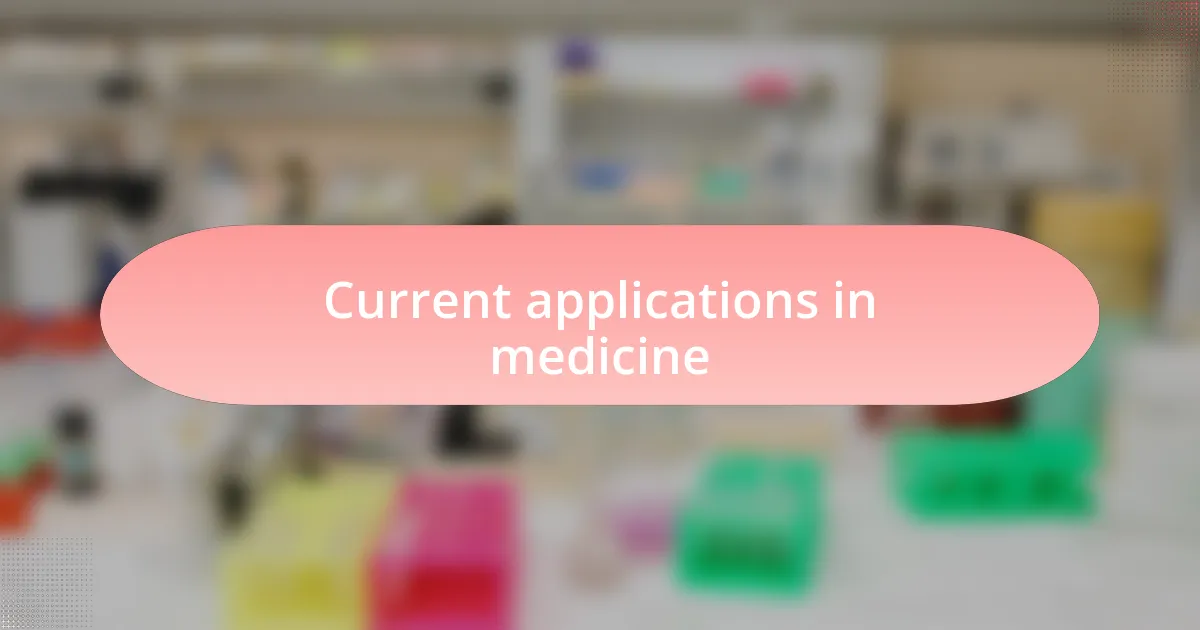Key takeaways:
- Stem cells have the unique ability to self-renew and differentiate into specialized cells, with potential applications in repairing tissues and regenerating organs.
- There are two main types of stem cells: embryonic stem cells, which can become any cell type, and adult stem cells, which have more limited differentiation capacity.
- Stem cell research offers hope for treating conditions like Parkinson’s disease and heart disease, with the potential for transformative medical advancements.
- Current applications include stem cell therapies for blood disorders and regenerative medicine for cartilage repair, showcasing the significant impact of this research on patient outcomes.

What are stem cells
Stem cells are unique cells capable of self-renewal and differentiation into various cell types in the body. Their remarkable potential lies in their ability to develop into specialized cells, such as muscle, nerve, or blood cells, which raises an intriguing question: what if we could harness this ability to repair damaged tissues or even regenerate organs? I often find myself reflecting on the possibilities, especially when I think about how my own health or loved ones’ health could benefit from such advances.
These cells exist in two main types: embryonic stem cells, which can develop into any cell type, and adult stem cells, which are more limited. I remember attending a seminar where a researcher passionately described how adult stem cells, found in our bone marrow and fat tissue, play a crucial role in maintaining and repairing our bodies. It struck me how these stem cells, often overlooked, serve as our internal first responders, working tirelessly to heal us.
I find it fascinating that while the idea of using stem cells for treatment is filled with promise, it’s also intertwined with ethical considerations, particularly regarding their origin. This intersection of hope and dilemma often leaves me pondering the balance we must strike. How do we reconcile the scientific possibilities with the moral implications? It’s a thought-provoking topic that challenges us to think deeply about the future of medical innovation.

Importance of stem cell research
Stem cell research holds immense significance in the landscape of medical innovation. As I reflect on its potential to revolutionize treatments for diseases that currently seem insurmountable, I can’t help but feel a sense of urgency. For instance, disorders like Parkinson’s and heart disease could one day be addressed by regenerating the damaged tissues with stem cells, offering hope to millions battling these conditions.
What really captivates me is the idea of stem cells as a bridge between science and human experience. I recall a conversation with a friend whose mother was diagnosed with leukemia. The mention of stem cell transplants sparked a glimmer of hope in their eyes, highlighting how critical this area of research is for real families facing heartbreaking situations. It begs the question: how many lives could be transformed if we fully embraced the possibilities that stem cells offer?
Moreover, the application of stem cells in regenerative medicine could redefine healing as we know it. I remember when I first learned about the concept of growing organs in the lab from stem cells. It made me think about the long waiting lists for transplants and how this research could ultimately eliminate such dire circumstances. Isn’t it inspiring to imagine a future where organ failure becomes a thing of the past? It’s this vision that fuels my passion for supporting further exploration in stem cell research.

Types of stem cells
When discussing the types of stem cells, it’s essential to differentiate between embryonic and adult stem cells. Embryonic stem cells are derived from early-stage embryos and possess the extraordinary ability to differentiate into any cell type in the body. This versatility fascinates me; it makes me wonder about the endless possibilities in regenerative medicine. Just imagining a future where we can create any kind of cell to replace damaged ones in the body is thrilling.
On the other hand, adult stem cells, which exist in various tissues like bone marrow and the brain, have more limited differentiation capabilities. They can typically only turn into cell types related to their tissue of origin. I often think about how my grandmother relied on adult stem cells from her own body to aid in her recovery after a severe injury. It’s a testament to how our bodies hold incredible potential for healing, even though it’s more restricted than that of embryonic stem cells.
Then there are induced pluripotent stem cells (iPSCs), a remarkable breakthrough where scientists reprogram adult cells to behave like embryonic ones. This innovation stirs my curiosity; it feels like we’re stepping into new realms of possibility in personal medicine. Could we one day use our own cells to generate compatible tissues for ourselves? The thought ignites a sense of hope mixed with excitement as I envision personalized treatments becoming the norm.

Current applications in medicine
Current applications of stem cells in medicine demonstrate just how impactful this field has become. For instance, stem cell therapies are already in use for treating blood disorders. I remember the story of a young boy with leukemia who received a stem cell transplant; it was awe-inspiring to witness how the procedure transformed his health and gave him a second chance at life.
Another significant application is in regenerative medicine, particularly in cartilage repair. When I first learned about the use of stem cells to regenerate cartilage in joints, I couldn’t help but think about athletes who face debilitating injuries. The possibility of restoring their mobility without invasive surgery brings real hope to many, myself included, as I enjoy staying active and know how crucial joint health is.
Moreover, ongoing research on stem cells holds potential for neurological conditions like Parkinson’s disease. Can you imagine a future where we can combat neurodegenerative diseases? That’s a future I long for, especially considering how devastating these illnesses can be for both patients and their loved ones. Every study brings us one step closer to potentially restoring lost functions and enhancing the quality of life for so many.